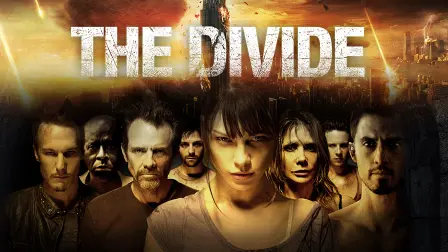The Divide (2011)
- movieslovers
- October 17, 2024

Suggested videos for you: Movie Review ] Resurrected Mummy: The Battle to Reclaim a Lover’s Sou
Suggested videos for you: [ Movie Review ] Mysterious Fog Wipes Out All Life on the Cursed Island || The Fog
Suggested videos for you: Movie Review] Doctor Strange (2016)
Suggested videos for you: [Movie Review] The Watchers (2024)
Overview: The Divide is a 2011 post-apocalyptic thriller directed by Xavier Gens and stars Lauren German, Michael Biehn, Milo Ventimiglia, and Rosanna Arquette. Set in the aftermath of a nuclear attack on New York City, the film explores the psychological and moral disintegration of a group of survivors who take refuge in the basement of an apartment building. Known for its intense atmosphere, graphic violence, and disturbing portrayal of human behavior under extreme stress, The Divide is a grim look at the lengths people will go to survive when pushed to the brink.
Plot Summary: The story begins with a nuclear explosion devastating New York City, forcing a group of nine tenants to take shelter in the basement of their apartment building, managed by Mickey (Michael Biehn), a former firefighter with a survivalist mindset. The survivors include Eva (Lauren German) and her boyfriend Sam (Iván González), brothers Josh (Milo Ventimiglia) and Adrien (Ashton Holmes), and other neighbors like Marilyn (Rosanna Arquette) and her daughter.
As the group struggles to adjust to their confined surroundings, tensions quickly rise. Food and water become scarce, tempers flare, and paranoia spreads. The pressure cooker environment turns even more volatile when a mysterious group of soldiers breaches the basement, only to kidnap Marilyn’s daughter and seal the survivors back inside, leaving them even more desperate.
With no way out, the survivors’ situation deteriorates into violence, power struggles, and betrayal. The basement becomes a battleground where humanity is stripped away layer by layer, revealing the darker sides of each character. As sanity slips and brutality takes over, the group splinters into factions, and survival becomes a matter of enduring the escalating madness.
Character Development: The film’s focus on character interactions is both its strength and its source of tension. The descent into barbarity is portrayed through the breakdown of the survivors’ personalities, each showing how trauma and desperation can bring out the worst in people.
- Eva (Lauren German) serves as the audience’s emotional anchor. She tries to maintain a sense of morality and sanity despite the chaos around her. Her struggle to retain her humanity amidst the horror makes her a sympathetic character, but she is also deeply affected by the unfolding atrocities.
- Mickey (Michael Biehn) is initially presented as a gruff but prepared leader who controls access to the supplies. His paranoid and abrasive personality quickly makes him a point of contention with the others, and as tensions escalate, he becomes both a protector and a threat.
- Josh (Milo Ventimiglia) undergoes one of the most disturbing transformations in the film. Starting as a seemingly normal young man, he becomes increasingly violent and domineering as the situation deteriorates, eventually becoming one of the film’s main antagonists. His arc highlights how power can corrupt and how survival can bring out a person’s inner darkness.
- Marilyn (Rosanna Arquette) and the other characters each struggle with the psychological toll of their confinement. As hope fades, Marilyn becomes emotionally unhinged, reflecting the fragility of the group’s mental state. The varying responses to their dire situation show the spectrum of human reactions to trauma, from despair to aggression.

Cinematography and Atmosphere: The cinematography by Laurent Barès effectively captures the claustrophobic and oppressive atmosphere of the basement. The film’s tight, confined shots mirror the characters’ sense of entrapment, using dim lighting and decaying set design to emphasize the grim reality of their situation. The visuals become progressively darker and more chaotic as the characters descend into madness, reflecting the emotional and moral decay of the group.
The setting of the basement, filled with broken furniture, exposed pipes, and makeshift barriers, becomes a physical manifestation of the characters’ deteriorating mental state. The film’s use of close-ups and handheld camera work creates an intimate but unsettling feel, putting the viewer directly in the center of the group’s disintegration.
Direction and Pacing: Xavier Gens’ direction is uncompromising, focusing on the brutal and raw nature of the survivors’ struggle. The pacing is deliberate, allowing tension to build slowly as relationships deteriorate and conflicts come to a head. The film’s descent into violence is unflinching, with each act of cruelty escalating the sense of despair.
Gens uses the confined setting to create a pressure-cooker environment, ensuring that even moments of relative calm are underscored by an impending sense of doom. This approach makes the film feel like a psychological thriller as much as it is a survival story, keeping viewers on edge as they anticipate the next explosive confrontation.
Themes: The Divide explores themes of survival, the loss of humanity, and the effects of isolation and trauma. It delves into how people respond when stripped of societal norms and forced to confront their primal instincts. The film is a bleak examination of what happens when individuals are pushed beyond their limits, portraying how fear and desperation can turn neighbors into adversaries.
The story also touches on the idea of power dynamics in survival situations, questioning who gets to lead and how that authority is maintained or challenged. The film’s portrayal of the breakdown of social order is extreme but effective in highlighting how quickly civilized behavior can collapse when the veneer of normalcy is shattered.
Violence and Tone: The film is known for its graphic violence and disturbing content. As the survivors’ behavior becomes more unhinged, scenes of brutality and cruelty become more frequent, making The Divide a difficult watch for those sensitive to such content. The tone is relentlessly bleak, offering little hope or redemption for the characters as their world spirals out of control.
This unrelenting darkness serves the film’s narrative, but it also means that The Divide can be emotionally draining for viewers. The uncompromising portrayal of human depravity forces audiences to confront the darker aspects of human nature, making the film more impactful but also more challenging to endure.
Conclusion: The Divide is a harrowing and uncompromising look at the dark side of human survival. It uses its claustrophobic setting and intense performances to explore themes of power, desperation, and the fragility of civilization. While its bleakness and graphic content may be off-putting for some, it stands as a thought-provoking entry in the post-apocalyptic genre, offering a psychological depth that sets it apart from more action-oriented survival stories.
The film’s exploration of the moral degradation that accompanies extreme conditions is not for the faint of heart, but for those who appreciate intense, character-driven stories, The Divide offers a disturbing yet compelling journey into the abyss of human nature. It serves as a stark reminder that, in the face of true desperation, the real monsters can often be found within.











